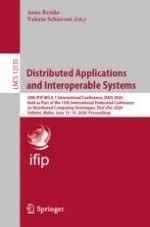2020 | Buch
Distributed Applications and Interoperable Systems
20th IFIP WG 6.1 International Conference, DAIS 2020, Held as Part of the 15th International Federated Conference on Distributed Computing Techniques, DisCoTec 2020, Valletta, Malta, June 15–19, 2020, Proceedings
herausgegeben von: Anne Remke, Valerio Schiavoni
Verlag: Springer International Publishing
Buchreihe : Lecture Notes in Computer Science
